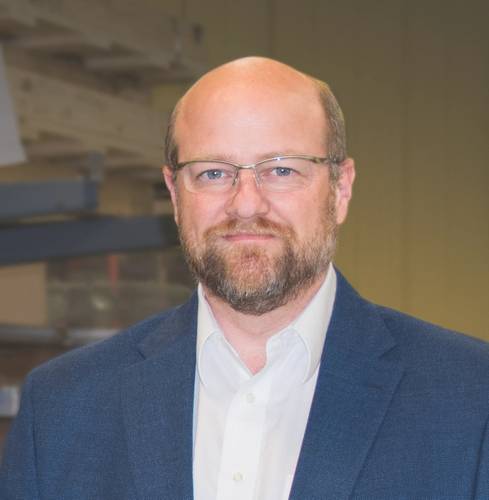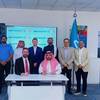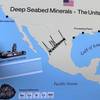INSIGHTS: Sean Fernstrum, President, R.W. Fernstrum
This month, listen in as Sean Fernstrum weighs in on how his firm arrived at its enviable market position, what comes next, and why.
Sean Fernstrum is a third-generation owner of R.W Fernstrum & Company. He graduated from Michigan Technological University in 1990 with a Bachelor of Science degree in Scientific and Technical Communications. After college, he came home to Menominee, Michigan and began working as a Technical Writer at R.W. Fernstrum & Company. He has been President of the company for the last 8 years. Sean has worked with a number of marine industry, local community, and charitable organizations throughout his career, including the PVA Associate Council, Rotary International, United States Power Squadrons, Boy Scouts of America, Advisory and Alumni Boards at Michigan Technological University.
It is no secret that R.W. Fernstrum & Company has been engineering and manufacturing GRIDCOOLER Keel Coolers for the marine industry since 1949. Fernstrum has since partnered with WEKA Boxcoolers B.V. and Tranter to expand its product offerings. These products are used for cooling marine propulsion engines, generator sets, reduction gears, and auxiliary systems onboard vessels of all sizes worldwide. Each solution is engineered to meet the requirements of a particular engine, vessel, and operating conditions.
Fernstrum set the standard in marine cooling systems over 65 years ago, building a reputation focused on innovation. Indeed, the firm is arguably in a class by itself when it comes to discussing any marine OEM market vendors.
In an era of increasingly complicated regulations and sophisticated technologies disrupting the workboat sector, one piece of the equipment – the Keel Cooler – remains as possibly the most important and at the same time, the simplest piece of hardware on the water. That hasn’t changed much over time, has it?
My grandfather started R. W. Fernstrum & Company in 1949. Over the past 70 years, we’ve seen the vessels in this industry evolve to meet the increased demands of today, both regulatory and operational. Successful equipment manufacturers have evolved their product lines as well. While the keel coolers we built in the past may look like our keel coolers today, and it’s not uncommon to find our GRIDCOOLER keel coolers built back in the 1950’s still in service today, most of those keel coolers wouldn’t meet our current quality control requirements.
Although the keel cooler is an unquestionably simple piece of equipment, over time, there must have been tweaks and changes that improve the product line as it matches the changes and increases in technology on board a given hull. Give us some examples of that metric in play.
Back to evolution, as the steel alloy in boat hulls changed in the early 1970’s, the hulls became less rigid and more flexible. This led us to tighten up our quality control specifications as well as make changes in the copper alloys we use in our tubing and the silver content of our braze wire. In 1981, the depression in our industry pushed us into custom designed units. Whether it one or one hundred (and it was a lot more of the one, than one hundred), we would make the customizations necessary to better meet the customer’s needs and get that job. The 1990’s lead us to a number of variations and improvements. Working with a customer to limit thru-hull fittings led to our Z-Option or flanged units. Improving the heat exchange in a given space led to our enhanced tubing. Work with one of our European representatives brought us the WEKA Boxcooler. More recently, we have our double stacked and angled tube units along with the addition of the Tranter product line. These are a few of the improvements and changes we’ve made, and there’s more to come.
As EPA Tier levels move on up to levels 3 and 4, the mighty keel cooler has matched strides to make sure that cleaner air doesn’t also mean poorly performing or out-of-service boats. In many cases, higher tier, cleaner engines also translate into much more heat generated in the engine spaces. How much (and where) have the tier changes impacted what you design and produce?
The impact has been in three key variables: heat exchange, coolant flow and coolant/seawater temperature differential. We need to dissipate more heat with less coolant in temperatures closer to ambient seawater temperature. This all means more surface area for the keel cooler to work properly. The same model engine with the same power rating at a different tier level is a very different animal.
Subchapter M rules, specifically those that that center on hull penetrations represent a potential challenge for operators that employ keel coolers. Fernstrum equipment is already in compliance with the U.S. Coast Guard’s tough subchapter K requirements (for passenger vessels). Do these match what is now in effect for subM vessels? Tell us about the challenges facing inland towboat operators and where Fernstrum can provide the ideal solution(s).
In the passenger vessel market, the way to meet regulations on thru-hull fittings has been with cofferdams. The other way we have met the needs of that market is by providing our Z-Option units. For these installations, a pipe stub penetrates the hull and all of the fittings are external to the hull.
Your year-on-year sales, and year to date, are up significantly. What’s driving those numbers and secondly, do you think this increased business reflects a general rebound in the workboat sectors as a whole?
I think we’re seeing the most demand from the tug, pushboat and ferry markets, at this point. Customers are making demands on operators to move more goods with newer equipment. Cities are seeing their lack of expansion opportunities on land for transportation infrastructure and looking to navigable waterways as a solution. All of this means work for us. As one market segment falls, another usually picks up. Sure there’s sometimes a lag and not all of those segments are created equal, but the work is out there if you look for it.
Because keel coolers are closed circuit cooling systems for a marine engine and these units are in direct contact with the ambient water, is the vessel’s intended service – for example, warmer climates, Arctic operations, etc. – taken into consideration when designing a keel cooler for a particular vessel?
Absolutely. We have to always consider where a vessel will be designed to operate as well as where it’s going to be built. A vessel built in the Gulf for service in Alaska has to have a cooling system designed for both conditions. You won’t pass sea trials in 90 degree Gulf seawater on a vessel designed strictly for 55 degree Arctic seawater.
Inland operators have options when it comes to cooling requirements. That said; most inland marine vessel operators tend to prefer to be keel cooled because of the dirty, shallow water environments that they operate in. Why is this true?
Simplicity and reliability. Seawater pumps, seacocks, strainers and seawater piping are all eliminated with keel coolers, and how often do you think an operator wants to be dead in the water with 20 barges or a load of passengers while they spend 15 minutes changing out strainers?
Fernstrum’s heat transfer testing occurs in-house, electronically with software and in test tanks at the Fernstrum facilities. You’ve invested a lot of time, talent and treasure in these testing facilities. Where is the testing done and how is that simulation accomplished?
Research and development is an important part of our business. While we’ve always been able to run a variety of physical tests in house at our facility, we’ve also had the ability to do CFD testing with our computer systems for some time now. The CFD testing allows us to test out new theories with lower costs and time requirements than physical testing. However, CFD can’t replace physical testing. We always run physical tests on ideas that show promise in CFD before rolling them out into production.
Are all of your keel coolers manufactured here at home in the United States?
All of our FERNSTRUM GRIDCOOLER keel coolers are made here in Menominee, Michigan, and all of the WEKA Boxcoolers sold in the Americas are built here as well. All of the Tranter Platecoil and many of the Tranter Superchangers are made in Wichita Falls, Texas.
You frequently see a life cycle of 20 years for a copper nickel keel cooler. But, at the same time, some of your customers tell of keel coolers that have lasted 30 to 40 years, spanning even more than one repower job. That said; what’s the warranty for one of your keel coolers?
Our copper-nickel keel coolers have a standard two year warranty. Our aluminum coolers have a 90 day warranty. Both should last a minimum 20 years.
Here and overseas, Fernstrum continues to drive trends in emerging markets. These include underwater tidal turbines, AUV’s and ROV’s. Tell us a bit about that work and what these markets entail when it comes to your product line.
You need to be able to create a real-world solution to a theoretical problem. That requires working closely with the project engineers, having the expertise and a clear understanding of what you can and can’t manufacture in a product, and understanding how your product will operate in conjunction with other systems and sub-systems in an application.
And, speaking of foreign markets, dispelling the notion that U.S. firms – maritime firms in particular – can’t compete overseas, Fernstrum does so and in a regular and robust fashion. If you can, share with us how much of your production eventually is shipped offshore. Where are your primary markets?
This year, about 30% of our sales are outside of the U.S. in 53 countries across 6 continents. Canada, South America, Europe and Asia make up the bulk of those sales. You can always compete. The key is being able to have good local representation in a given region.
The advent of hybrid systems has brought in new business – the business of cooling electronics, converters, transformers, and DC motors. What’s the key difference in those applications as opposed to the areas that you have traditionally serviced?
We’ve worked with diesel-electric systems since the 1960’s. We cooled prototype LNG and CNG systems in the 1990’s. We’ve been doing electric and hybrid systems for years.
Given the increasing complexity of today’s workboats and the advent of technology like never before on the water, the durable and simple GRIDCOOLER Keel Cooler is a piece of equipment that transcends those changes. Would you agree? And, what advice would you give the typical workboat operator looking for the right cooling solution?
Until we can conquer friction on all equipment with moving parts along with the ability to transfer 100% of power from one state or device to another, we will always have a need for heat dissipation. That’s what we do. That’s the problem we solve for our customers every day. If you’re looking for a cooling solution, remember that you need a solution to YOUR problem, not a one-size-fits-all product that may or may not solve that problem.
This article first appeared in the November print edition of MarineNews magazine.
















